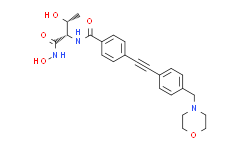| Cas No.: | 728865-23-4 |
| Chemical Name: | CHIR-090 |
| Synonyms: | CHIR-090;CHIR 090;N-[(2S,3R)-3-hydroxy-1-(hydroxyamino)-1-oxobutan-2-yl]-4-[2-[4-(morpholin-4-ylmethyl)phenyl]ethynyl]benzamide;(2S,3R)-N-(2-hydroxy-1-hydroxycarbamoylpropyl)-4-(4-morpholin-4-ylmethylphenylethynyl)benzamide;C90;CHEBI:49528;CHEMBL260091;CS-0973;DB07536;HY-15460;N-{(1s,2r)-2-Hydroxy-1-[(Hydroxyamino)carbonyl]propyl}-4-{[4-(Morpholin-4-Ylmethyl)phenyl]ethynyl}benzamide;N-((2S,3R)-3-Hydroxy-1-(hydroxyamino)-1-oxobutan-2-yl)-4-((4-(morpholinomethyl)phenyl)ethynyl)benzamide;CHIR090;CHIR 090;CHIR090;BCP06103;3541AH;BDBM50200120 |
| SMILES: | O1C([H])([H])C([H])([H])N(C([H])([H])C2C([H])=C([H])C(C#CC3C([H])=C([H])C(=C([H])C=3[H])C(N([H])[C@]([H])(C(N([H])O[H])=O)[C@@]([H])(C([H])([H])[H])O[H])=O)=C([H])C=2[H])C([H])([H])C1([H])[H] |
| Formula: | C24H27N3O5 |
| M.Wt: | 437.4883 |
| Sotrage: | 2 years -20°C Powder, 2 weeks 4°C in DMSO, 6 months -80°C in DMSO |
| Description: | CHIR-090 is a potent, slow, tight-binding inhibitor of the LpxC deacetylase. It binds to E. coli LpxC with a Ki of 4.0 nM. |
| In Vivo: | CHIR-090 is a potent antibiotic against E. coli and inhibits E. coli LpxC activity in vitro in the low nM range. E. coli W3110 colonies resistant to 1 μg/mL CHIR-090 are not observed without prior chemical mutagenesis. A strain of E. coli W3110 is able to grow on LB agar plates containing 1 to 10 μg/mL CHIR-090, which is 4 to 40 times above the MIC of 0.25 μg/mL under our conditions for wild-type E. coli W3110. The doubling time of W3110RL is 40 min in the presence of 1 μg/mL CHIR-090, which is exactly the same rate as wild-type in the absence of inhibitor. Wild-type cells stopped growing after about 2 h in the presence of 1 μg/mL CHIR-090[1]. |
| In Vitro: | CHIR-090 is a potent, slow, tight-binding inhibitor of the LpxC deacetylase from the hyperthermophile Aquifex aeolicus, and it has excellent antibiotic activity against P. aeruginosa and E. coli, as judged by disk diffusion assays. CHIR-090 is also a two-step slow, tight-binding inhibitor of Escherichia coli LpxC with Ki=4 nM. CHIR-090 at low nM levels inhibits LpxC orthologues from diverse Gram-negative pathogens, including Pseudomonas aeruginosa, Neisseria meningitidis, and Helicobacter pylori. In contrast, CHIR-090 is a relatively weak competitive and conventional inhibitor (lacking slow, tight-binding kinetics) of LpxC from Rhizobium leguminosarum (Ki=340 nM), a Gram-negative plant endosymbiont that is resistant to this compound. An E. coli construct in which the chromosomal lpxC gene is replaced by R. leguminosarum lpxC is resistant to CHIR-090 up to 100 μg/mL, or 400 times above the minimal inhibitory concentration for wild-type E. coli. CHIR-090, a very potent, slow, tight-binding inhibitor of Aquifex aeolicus LpxC, the sequence of which is 31 % identical to E. coli LpxC. CHIR-090 has remarkable antibiotic activity against E. coli and P. aeruginosa, comparable to ciprofloxacin, as judged by disk diffusion assays[1]. |

 DC Chemicals' products qualify for U.S. tariff exemptions. We guarantee no price increases due to customs duties and maintain stable supply, continuing to deliver reliable research solutions to our American clients.
DC Chemicals' products qualify for U.S. tariff exemptions. We guarantee no price increases due to customs duties and maintain stable supply, continuing to deliver reliable research solutions to our American clients.





















